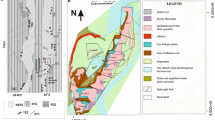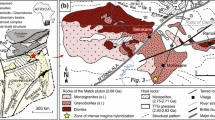Abstract
Aplite dikes intruding the Proterozoic 1.42(± 3) Ga Longs Peak-St. Vrain Silver Plume-type peraluminous granite near Jamestown, Colorado, contain F, P, and rare earth element (REE)-rich globular segregations, with 40–46% REE, 3.7–4.8 wt% P2O5, and 5–8 wt% F. A combination of textural features and geochemical data suggest that the aplite and REE-rich globular segregations co-existed as two co-genetic liquids prior to their crystallization, and we propose that they are formed by silicate–fluoride + phosphate (+ S + CO2) melt immiscibility following ascent, cooling, and decompression of what was initially a single homogeneous magma that intruded the granite. The REE distribution coefficients between the silica-rich aplites and REE-rich segregations are in good agreement with experimentally determined distribution coefficients for immiscible silicate–fluoride + phosphate melts. Although monazite-(Ce) and uraninite U–Th–Pb microprobe ages for the segregations yield 1.420(± 25) and 1.442(± 8) Ga, respectively, thus suggesting a co-genetic relationship with their host granite, εNd1.42Ga values for the granites and related granitic pegmatites range from − 3.3 to − 4.7 (average − 3.9), and differ from the values for both the aplites and REE-rich segregations, which range from − 1.0 to − 2.2 (average − 1.6). Furthermore, the granites and pegmatites have (La/Yb)N <50 with significant negative Eu anomalies, which contrast with higher (La/Yb)N >100 and absence of an Eu anomaly in both the aplites and segregations. These data are consistent with the aplite dikes and the REE-rich segregations they contain being co-genetic, but derived from a source different from that of the granite. The higher εNd1.42Ga values for the aplites and REE-rich segregations suggest that the magma from which they separated had a more mafic and deeper, dryer and hotter source in the lower crust or upper mantle compared to the quartzo-feldspathic upper crustal source proposed for the Longs Peak-St. Vrain granite.






Similar content being viewed by others
Change history
10 September 2018
In the version of the paper originally published the current address of author Jeremy T Ross was given incorrectly as Untied Status Marine Corp, 3351 Onslow Drive, Camp Lejeune, NC 28547, USA.
References
Affholter KA (1987) Synthesis and crystal chemistry of lanthanide allanites. PhD dissertation, Virginia Polytechnic Institute and State University
Affholter KA, Adams IW (1987) Thermal breakdown of allanite to britholite. GSA Abstracts Progr 19:567
Allaz J, Persson PM, Raschke MB, Stern CR (2015) Proterozoic fluorbritholite-bearing REE-rich hydrothermal pods and veins from near Jamestown, CO. Am Mineral 100:2123–2140
Anderson JL, Thomas WM (1985) Proterozoic anorogenic two-mica granites: Silver Plume and St. Vrain batholiths of Colorado. Geology 13(3):177–180
Baker F, Hedge CE, Millard HTJ, O’Neil JR (1976) Pikes Peak batholith: geochemistry of some minor elements and isotopes, and implications for magma genesis. In Professional Contributions of Colorado School of Mines. Stud Colorado Field Geol 8:44–56
Bowen NL (1928) The evolution of the igneous rocks. Princeton University Press, Princeton
Bradley S (1985) Granulite facies and related xenoliths from Colorado-Wyoming kimberlites. MSc Dissertation, Colorado State University
Chakhmouradian AR, Wall F (2012) Rare earth elements: minerals, mines, magnets (and more). Elements 8:333–340
Chakhmouradian AR, Zaitsev AN (2012) Rare earth mineralization in igneous rocks: sources and processes. Elements 8:347–353
Christiansen E, Haapala I, Hart G (2007) Are Cenozoic topaz rhyolites the erupted equivalents of Proterozoic rapakivi granites? Examples from the western United States and Finland. Lithos 97:219–246
Cole JC, Braddock WA, Colorado N-C (2009) Geologic Map of the Estes Park 30′ × 60′ Quadrangle. US Geol Survey Sci Investig Map 3039:1
DePaolo DJ (1981) Neodymium isotopes in the Colorado Front Range and crust-mantle evolution in the Proterozoic. Nature 291:193–196
Dolejš D, Baker DR (2007a) Liquidus equilibria in the system K2O–Na2O–Al2O3–SiO2–F2O1–H2O to 100 MPa: I. Silicate–fluoride liquid immiscibility in anhydrous systems. J Petrol 48:785–806
Dolejš D, Baker DR (2007b) Liquidus equilibria in the system K2O–Na2O–Al2O3–SiO2–F2O– 1–H2O to 100 MPa: II. Differentiation paths of fluorosilicic magmas in hydrous systems. J Petrol 48:807–828
Drivenes K, Larsen RB, Müller A, Sørensen BE, Wiedenbeck M, Raanes MP (2015) Late-magmatic immiscibility during batholith formation: assessment of B isotopes and trace elements in tourmaline from the Land’s End granite, SW England. Contrib Mineral Petrol 169: https://doi.org/10.1007/s00410-015-1151-6
Eggler DH, Meen JK, Welt F, Dudas FO, Furlong KP, McCallum ME, Carlson RW (1987) Tectonomagmatism of the Wyoming Province, Colorado. School Mines Quart 82:25–40
Farmer GL, Broxton ED, Warren RG, Pickthon W (1991) Nd, Sr, and O isotopic variations in metaluminous ash-flow tuffs and related volcanic rocks at Timber Mountain/Oasis Valley Caldera, Complex, SW Nevada: implication for the origin and evolution of large-volume silicic magma bodies. Contrib Mineral Petrol 109:53–68
Gay P (1957) An X-ray investigation of some rare-earth silicates: cerite, lessingite, beckelite, britholite, and stillwellite. Mineral Mag 31(237):455–468
Goddard EN, Glass JJ (1940) Deposits of radioactive cerite near Jamestown, Colorado. Am Mineral 25(6):381–404
Gramenitskiy EN, Shchekina TI (1994) Phase relationships in the liquidus part of a graniticsystem containing fluorine. Geochem Int 31:52–70
Gramenitskiy EN, Shchekina TI (2005) Behavior of rare earth elements and yttrium during the final differentiation stages of fluorine-bearing magmas. Geochem Int 43:39–52
Gysi A, William-Jones AE, Collins P (2016) Lithogeochemical vectors for hydrothermal processes in the Strange Lake peralkaline granitic REE-Zr-Nb deposit. Econ Geol 111:1241–1276
Jacob KH, Farmer GL, Buchwaldt R, Bowring SA (2015) Deep crustal anatexis, magma mixing, and the generation of epizonal plutons in the Southern Rocky Mountains, Colorado. Contrib Mineral Petro 169: https://doi.org/10.1007/s00410-014-1094-3
Klemme S (2004) Evidence for fluoride melts in Earth’s mantle formed by liquid immiscibility. Geol 32:441–444
Klemme S (2005) Evidence for fluoride melts in Earth’s mantle formed by liquid immiscibility: Comment and Reply: Reply. Geol 33:77
Peretyazhko IS, Zagorsky VY, Tsareva EA, Sapozhinikov AN (2007) Immiscibility of calcium fluoride and alumino-silicate melts in ongonites from the Ary-Bulak intrusion, Eastern Transbaikal region. Doklady Earth Sci 413:315–320
Peterman ZE, Hedge CE (1968) Chronology of Precambrian events in the Front Range, Colorado. Canad J Earth Sci 5:749–756
Peterman ZE, Hedge CE, Braddock W (1968) Age of Precambrian Events in the Northeastern Front Range, Colorado. J Geophy Res 73(6):2277–2296
Rabbitt JC (1952) Summary of the research work of the trace elements section geochemistry and petrology branch for the period July 1 - September 30, 1951. US Geol Surv report TEI-182
Sinclair WD, Richardson JM (1992) Quartz–tourmaline orbicules in the Seagull Batholith, Yukon Territory. Canad Mineral 30:923–935
Smith DR, Noblett J, Wobu RA, Unruh D, Douglass J, Beane R, Davis C, Goldman S, Kay G, Gustavson B, Saltoun B, Stewart J (1999) Petrology and geochemistry of late-stage intrusions of the A-type, mid-Proterozoic Pikes Peak batholith (Central Colorado, USA): implications for petrogenetic models. Precamb Res 98:271–305
Smith MP, Moore K, Kavecsánszki D, Finch AA, Kynicky J, Wall F (2016) From mantle to critical zone: a review of large and giant sized deposits of the rare earth elements. Geosci Front 7:315–334
Stern CR, Huang WL, Wyllie PJ (1975) Basalt-andesite-rhyolite-H2O: crystallization intervals with excess H20 and H20-undersaturated liquidus surfaces to 35 kilobars, with implications for magma genesis. Earth Planet Sci Letts 28:189–196
Trumbull RB, Krienitz MS, Gottesmann B, Wiedenbeck M (2008) Chemical and boron-isotope variations in tourmalines from an S-type granite and its source rocks: the Erongo granite and tourmalinites in the Damara Belt, Namibia. Contrib Mineral Petrol 155:1–18
Tweto O (1979) Geologic map of Colorado, special publication, scale 1:500,000. U.S. Geological Survey, Reston
Vasyukova O, Williams-Jones AE (2014) Fluoride–silicate melt immiscibility and its role in REE ore formation: evidence from the Strange Lake rare metal deposit, Québec-Labrador, Canada. Geochim Cosmochom Acta 139:110–130
Vasyukova O, Williams-Jones AE (2016) The evolution of immiscible silicate and fluoride melts: implications for REE ore-genesis. Geochim Cosmochim Acta 172:205–224
Veksler IV (2004) Liquid immiscibility and its role at the magmatic–hydrothermal transition: a summary of experimental studies. Chem Geol 210:7–31
Veksler IV, Dorfman AM, Kamanetsky M, Dulski P, Dingwell DB (2005) Partitioning of lanthanides and Y between immiscible silicate and fluoride melts, fluorite and cryolite and the origin of the lanthanide tetrad effect in igneous rocks. Geochim Cosmochim Acta 69:2847–2860
Veksler IV, Dorfman AM, Dulski P, Kamenetsky VS, Danyushevesky LV, Jeffries T, Dingwell DB (2012) Partitioning of elements between silicate melt and immiscible fluoride, chloride, carbonate, phosphate and sulfate melts, with implications to the origin of natrocarbonatite. Geochim Cosmochim Acta 79:20–40
Acknowledgements
We thank P. Emery, T. Nystrom, and H. Scott from the Balarat Outdoor Education Center, Denver Public Schools, for providing access to the site, E. Anderson for assistance with data analysis, and also I. Veksler and O. Vasyukova for their helpful reviews of the manuscript. This work was supported by United States Geological Survey Mineral Resource External Research Program grant #G14AP00052.
Author information
Authors and Affiliations
Corresponding author
Additional information
Communicated by Timothy L. Grove.
Electronic supplementary material
Below is the link to the electronic supplementary material.
Rights and permissions
About this article
Cite this article
Stern, C.R., Allaz, J.M., Raschke, M.B. et al. Formation by silicate–fluoride + phosphate melt immiscibility of REE-rich globular segregations within aplite dikes. Contrib Mineral Petrol 173, 65 (2018). https://doi.org/10.1007/s00410-018-1497-7
Received:
Accepted:
Published:
DOI: https://doi.org/10.1007/s00410-018-1497-7




